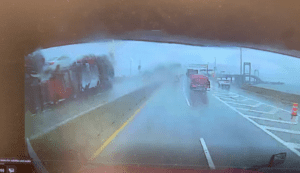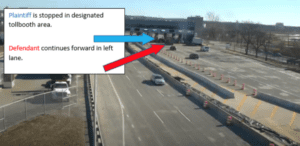Truck Accidents: What You Need to Know About Liability and Compensation
New York is on the list in the top 10 of deadliest states for driving in the US. Each day, thousands of trucks take to the streets of New York, and nearly all are involved in commerce of some sort. With road closures, traffic, and other delays, many truck drivers resort to breaking the law to meet their deadlines.
What many motorists are unaware of are the laws that exist in New York to hold truck drivers and operators responsible for their actions and keep the public safe. This article will outline all you need to know pertaining to trucking laws and provide some context on the work that Leav & Steinberg LLP has done and is doing for our clients.
If you or a loved one has been injured, contact us for a free consultation to find out if you can recover compensation for damages.
New York Trucking Regulations
New York State has various laws and regulations that pertain to truck drivers operating on its roadways. For the most part, these laws have been enacted to regulate the following:
- License eligibility
- Driver conduct
- Size limitations
- Cargo and hazardous materials
- Inspections
One important law regulating truck operators is New York State’s Commercial Driver’s License (CDL) requirements, which mandates that truck drivers obtain a CDL to operate commercial vehicles.
Next, truck drivers can be held liable for violating federal hours-of-service regulations, which limit the amount of time a driver can spend on the road before taking a mandatory rest break. Below is a breakdown of the hour limits, according to the Federal Motor Carrier Safety Administration (FMCSA) (1):
| Property Carrying Drivers | Passenger – Carrying Drivers |
| 11-Hour Driving Limit May drive a maximum of 11 hours after 10 consecutive hours off duty | 10-Hour Driving Limit May drive a maximum of 10 hours after 8 consecutive hours off duty |
| 14-Hour Driving Limit May not drive beyond the 14th consecutive hour after coming on duty, following 10 consecutive hours off duty | 15-Hour Driving Limit May not drive after having been on duty for 15 hours, following 8 consecutive hours off duty |
| 60/70-Hour Driving Limit May not drive after 60/70 hours on duty in 7/8 consecutive days | 60/70-Hour Driving Limit May not drive after 60/70 hours on duty in 7/8 consecutive days |
One of the most common causes of truck accidents is driver negligence, which include behaviors like:
- Driving while fatigued
- Distracted driving
- Driving under the influence of drugs or alcohol.
Hours-of-service regulations are in place to prevent against this behavior, which you will see is necessary to maintain safety.
Furthermore, truck drivers can also be held liable for failing to properly inspect or maintain their vehicle, which can result in mechanical failures and cause an accident. Federal Motor Carrier Safety Administration (FMCSA) stipulates several different inspection requirements for truck drivers (2):
- § 396.3(a): Every motor carrier shall systematically inspect, repair, and maintain, or cause to be systematically inspected, repaired, and maintained, all motor vehicles subject to its control.
- § 396.7 – Unsafe Operations: Commercial motor vehicles (CMVs) must not be operated in such a condition as to likely cause an accident or a breakdown of the vehicle.
- §396.17 – Annual Inspection: Every commercial vehicle, including each segment of a combination vehicle requires periodic inspection that must be performed at least once every 12 months.
The above rules and regulations are put in place as minimum requirements for truck drivers to conduct business on the roads legally. As they travel, truck drivers are subject to traffic laws and have a complex set of rules on how they can operate.
Due to the size of trucks, many are not allowed to operate within several areas of the five boroughs. There are low-hanging bridges, as well as a significant amount of foot traffic, that makes these trucks a safety hazard.
One major issue often overlooked is that a “truck,” by its nature, is often made of two parts: a tractor and a trailer. Very often, the two parts of the truck are owned by different entities and often carry their own separate insurance.
It is critical that, during legal discovery, you ask for and obtain the registration, ownership, and any other contractual proof of who owned and operated the tractor and trailer — as each part of the truck may very well have additional insurance to cover the injuries sustained.
How the Attorneys at Leav & Steinberg Can Help After a New York Truck Accident
An unfortunate reality about trucking accidents is that the stakes for injury are usually very high. When trucks cause accidents to smaller vehicles — or worse, pedestrians — the potential for serious injury is much higher.
What most people don’t realize about truck accidents is that the driver’s insurance companies are working tirelessly to settle your case and potentially limit the amount you’re able to recover.
In fact, if you were involved in an accident, chances are that the defense attorney or insurance company has already tried contacting you. You might already have a settlement offer on the table before even consulting with a lawyer. It’s important that you have an experienced legal team before accepting any settlement after an injury.
In some cases, contributory negligence laws exist to establish the blame for the accident. If the insurance company is able to prove that the victim of the accident was at fault, it can limit the amount they are able to cover.
As you will see below, our New York truck accident attorneys have worked with numerous victims of trucking accidents to ensure they get the results they deserve:
Truck Driver Rear Ends Vehicle on Highway

The video below depicts an accident where reckless driving on behalf of a large truck on the highway results in an accident with a smaller van. As you can see in the video, the truck is driving without due care for those vehicles around them. Additionally, the weather at the time of the accident called for increased care — which the truck driver failed to exhibit.
After suffering injury due to the negligence of the driver, the victim reached out to Leav & Steinberg to handle their case.
The Department of Transportation states that drivers should remain at least 1 second for every 10 feet of vehicle length behind the car in front of them. For a typical tractor trailer – this results in 4 seconds between the truck and the leading vehicle.
Since the truck driver failed to maintain proper distance, they caused the accident that left our client injured and with damaged property. Merely, the face that the driver hit the rear of our client’s vehicle is prima facie evidence of negligence. This means that it is accepted as “true” at first glance until proven otherwise.
Consider a similar case we are handling and have recently won a motion granting summary judgment for. This means that under the law, a judge has determined that because of the video evidence and the testimony, the defendant — the truck owner and driver — is 100% responsible, and our client is free and clear of any responsibility.

As the defendant (dump truck) is approaching the tollbooth, they fail to take proper caution and ultimately strike the rear of the plaintiff’s vehicle.
Contact a Truck Accident Lawyer Today
Unfortunately, these types of truck accidents are quite common in New York State. Our experienced team of attorneys are well-versed in the laws pertaining to all types of trucks and vehicle accidents. If you have been the victim of an automobile accident, involving a truck or otherwise, get a free consultation on your case at 212-766-5222.
Resources:
- https://www.fmcsa.dot.gov/regulations/hours-service/summary-hours-service-regulations#:~:text=Drivers%20must%20take%20a%2030,combination%20of%20these%20taken%20consecutively).
- https://www.fmcsa.dot.gov/safety/passenger-safety/inspection-repair-and-maintenance-motor-carriers-passengers-part-396#:~:text=General%20%E2%80%93%20%C2%A7%20396.3(a),vehicles%20subject%20to%20its%20control.









